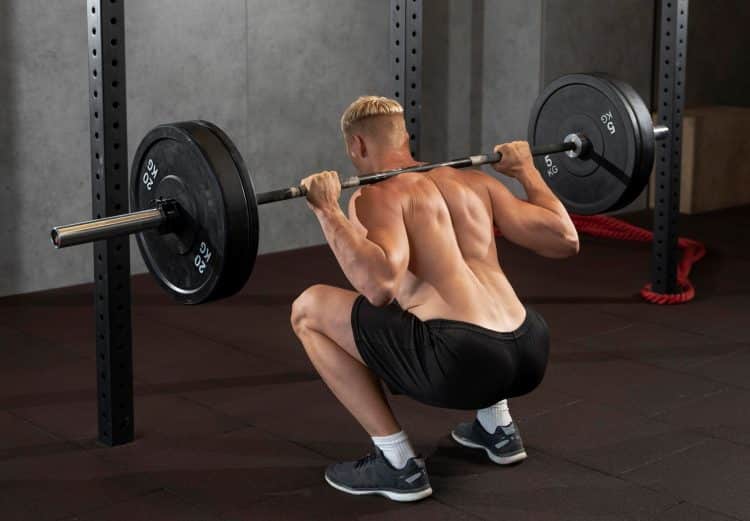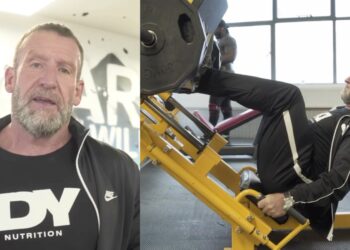The ‘Super Squats Program’ is an old-school bodybuilding program designed to help hard gainers build muscle. It goes to extreme lengths to help stimulate stubborn muscles and rewards lifters willing to tolerate the brutal program.
It is designed around a highly effective exercise we all know and love — the squat. Squats are an excellent lower body strength and muscle builder. They also tax the upper body as you must stabilize the barbell.
Heavy, low-rep squats can build muscle, but they are usually done to build one-rep maxes (1RM). The Super Squats Program involves performing 20 reps of squats with your 10-rep max weight. This forces you to push harder than you typically would. It is absolutely brutal and triggers a high amount of mechanical tension and metabolic stress.
The Super Squats Program also includes other compound exercises that train several muscle groups, ensuring balanced physique development.
One of the biggest intrigues of the Super Squats program is its claims to help you build 30 pounds of muscle within six weeks. However, this is highly unlikely, especially for natural lifters. We’ll talk more about what you can and can’t expect from this program later, but this is still a tried and true program with many benefits for people looking to quickly put on a significant amount of muscle.
The Super Squats Program
Level Up Your Fitness: Join our 💪 strong community in Fitness Volt Newsletter. Get daily inspiration, expert-backed workouts, nutrition tips, the latest in strength sports, and the support you need to reach your goals. Subscribe for free!
The Super Squats Program involves a three-day full-body training split with the same workout repeated each time. You’ll train on Monday, Wednesday, and Friday, with a rest day between each.
The program comprises heavy compound exercises that are basic yet highly effective and time-tested. How does the program get you to lift such heavyweights for such high reps? This is done in rest-pause style, where you pause between reps to finish the set. For example, after completing 10 reps, you’ll pause and take a few deep breaths to recover just enough to complete the set of 20.
Due to this breathing technique, Super Squats are also known as ‘breathing squats.’ Nonetheless, the program forces you to train extremely hard and continue to add weight to your lifts to get stronger and build muscle.
This program capitalizes on the most important strength training variables like volume, intensity, and progressive overload.
Here is the original Super Squats program:
| Exercise | Sets | Reps |
| Behind Neck Shoulder Press | 3 | 12 |
| Barbell Back Squat | 1 | 20 |
| Bench Press | 3 | 12 |
| Bentover Row | 3 | 15 |
| Stiff-Leg Deadlift | 1 | 15 |
| Pullover | 1 | 20 |
Super Squats Program for Hardgainers
The Super Squats Program was originally marketed as a bulking program for hardgainers. Hardgainers struggle to gain weight and build muscle mass. Doing an extreme program that forces you to lift super heavy on highly taxing exercises can be a great way to stimulate new muscle growth.
Why the Super Squats Program Works
For starters, it capitalizes on training frequency. Most lifters use a combination of upper-lower body split, training different muscle groups on different days. Most bodybuilding training splits include training chest on Mondays, back on Tuesdays, legs on Wednesdays, and arms on Fridays. Hence, most lifters don’t train a muscle more than once or twice weekly.
Considering that many lifters get stuck in the ‘bro split,’ switching to a higher frequency program involving full body training in each workout can be humbling and push you out of your comfort zone.
And just like I’ve already mentioned, this program is extremely simple to understand, making it great for lifters of all experience levels.
Most lifters, whether hardgainer or not, don’t see the desired muscle growth because they don’t train hard enough. Training intensity is one of the tenets of strength training you can’t work around. Intelligent programming means nothing if you don’t push yourself towards failure.
For those that don’t know, not all the reps you do within a set grow muscle. Generally, it’s the final reps that stimulate hypertrophy. This is because your muscle fibers experience much more tension towards the end of the set when your motor units are forced to push harder due to fatigue and metabolic stress accumulation.
With the Super Squats Program, I’ve noticed people push themselves harder than they’re used to. Pushing hard with lighter loads can be painful due to the lactic acid buildup. A 20-rep squat set requires a certain amount of mental strength that can help you in the long run whether or not you choose to stick with the Super Squats program.
This forces people to train harder than they normally would.
The Super Squats Program is so effective because it trains the entire body. The entire program only includes a few exercises, but each one trains multiple muscle groups.
Drawbacks of the Super Squats Program
Programs that guarantee 30 pounds of muscle in a short time usually have several drawbacks.
The first drawback is fatigue. Many people can’t fathom doing heavy barbell work three days a week, especially for joint-taxing exercises like barbell back squats and bench presses. You’ll do these exercises for very high reps and training to failure.
As I mentioned earlier, this can certainly be a benefit. Still, it can also be a drawback for people with weaker joints and ligaments and those who might not be advanced enough to tolerate this training style.
The other drawback is that it utilizes a rest-pause training style that can make tracking your progress more complex.
Straight sets are more standardized, which makes progress tracking easier. You have a fixed rep target for each set. The issue with rest-pause is that each set gets broken down into mini-sets. Each mini-set varies in frequency, reps, and rest times, making it difficult to standardize your performance.
Standardizing your performance is crucial as it is the guiding factor for determining when to increase the weight and how much. It also tells you if you should decrease the weight or deload. A beginner trying the Super Squats Program for the first time might mistake fatigue for growth. However, if they are not recovering and their performance is not going up, they are essentially destroying themselves and getting weaker.
Level Up Your Fitness: Join our 💪 strong community in Fitness Volt Newsletter. Get daily inspiration, expert-backed workouts, nutrition tips, the latest in strength sports, and the support you need to reach your goals. Subscribe for free!
So, while fatigue is inevitable and learning how to push past fatigue is important, having standard metrics to ensure objective performance progresses is also vital.
Finally, the Super Squats Program is quite limited in exercise selection. This is fantastic if you prefer a simple program. However, with such a limited exercise selection, you might be under-stimulating certain muscle groups that would be more effectively hit with additional isolation exercises. For example, the conventional barbell back squat primarily trains the gluteus maximus. The gluteus medius is understimulated because of the minimal hip abduction. This is why many modern bodybuilding programs include specific isolation exercises to close all the gaps that even the best compound exercises can leave.
Modernizing the Super Squats Program

Here’s how we can preserve the tenets of the Super Squats Program while making it more effective for modern-day bodybuilding. The program is fantastic but lacks isolation accessory exercises to train specific regions. Adding single-joint exercises will ensure you are maximizing muscle growth in all areas.
The hip abduction machine will help train your glute medius. The lying leg curl machine trains the hamstrings, and the lateral raises will ensure your side delts get trained sufficiently through their full range of motion.
Even one set of all of these allows for a more comprehensive program. You’ll be aiming for 20 reps in the isolation exercises to follow the theme of the squats.
| Exercise | Sets | Reps | Rest |
| Behind-the-Neck Press | 3 | 12 | 2-3 min |
| Barbell Back Squat | 1 | 20 | 2-3 min |
| Bench Press | 3 | 12 | 2-3 min |
| Bent Over Row | 3 | 15 | 2-3 min |
| Stiff-Legged Deadlift | 1 | 15 | 2-3 min |
| Pullover | 1 | 20 | 2-3 min |
| Seated Hip Abduction | 1 | 20 | 2-3 min |
| Dumbbell Lateral Raise | 1 | 20 | 2-3 min |
| Lying Leg Curl Machine | 1 | 20 | 2-3 min |
Additionally, you should use microplates. These add weight incrementally, which allows you to progress in load without killing yourself. Sometimes, that 5 or 10-pound jump with traditional plates is way too much, especially considering how often you are doing the same lifts each week in this program.
Although progressive overload is a must to build strength and muscle, you shouldn’t rush it as it can increase your odds of injury.
Super Squats Program Bulking Diet
The Super Squats Program is often paired with a bulking diet. Bulking simply means a calorie surplus. This is not, and never was, an excuse to eat whatever you want.
The original bulking diet that accompanied this program is quite excessive. It had a lot of food to ensure a calorie surplus, but the total calories were too high for most people. In the original diet, you had a glass of milk with whey protein at each meal and snack. However, this might not be the correct approach for people who already eat close to their TDEE. You will gain fat alongside muscle when you eat in an excessive surplus.
Here is the original Super Squats Program bulking diet:
Breakfast
- Four eggs
- Two slices of whole wheat toast
- One glass of milk with whey powder
Snack
- One cup oatmeal
- One glass of milk with whey powder
Lunch
- Sandwich (with meat, chicken, or tuna, and cheese)
- One or two pieces of fruit
- One glass of milk with whey powder
Snack
- One or two pieces of fruit
- Cottage cheese or other cheese
- One glass of milk with whey powder
Supper
- Meat (i.e., chicken, beef, pork, etc.)
- Whole wheat pasta, rice, potatoes, or sweet potatoes
- Green vegetables
- One glass of milk with whey powder
Snack
- One cup whole grain cereal, cream of wheat/rice, or grits
- One glass of milk with whey powder
Modernizing the Super Squats Bulking Diet
Bulking diets certainly have their merits. People often start bulking when they reach a more advanced level, where eating more aids the body in building muscle and strength. So, maintaining a calorie surplus is undoubtedly important. The calorie surplus will ensure you have the fuel to train hard and recover optimally to build muscle and strength. That said, research finds that going too high of a surplus simply results in excessive body fat. (1)
For example, research finds that eating in a 15% surplus compared to a 5% surplus did not produce additional muscle growth. (2)
You can certainly draw inspiration from the original Super Squats Program bulking diet and adjust it as needed. It is simple and easy to follow but will likely lead to fat gain. Plus, an average person will struggle to drink a glass of milk with protein powder five times daily.
So, instead, multiply your body weight by 20 and use it as a reference point for your daily calorie intake goal. You can always adjust it depending on your progress, goal, and current physique. If you don’t gain weight within two weeks, increase your calories. Conversely, you can reduce your calorie intake if you gain more than 1% of your body weight each week. At the end of the day, we are attempting to build a lot of muscle while minimizing fat gain.
As for food choices, the original Super Squats bulking diet already has some solid food choices. I would recommend increasing your vegetable and fruit intake a bit to ensure that you get enough essential vitamins and minerals to prevent deficiencies and maximize physical performance.
If you don’t want to track your calories, you can start with the original Super Squats Program bulking diet, but be sure to adjust the amount of food each week based on your progress. Most people will gain weight quickly, so reducing your food intake at the right times is vital to minimize fat gain. Alternatively, if the original template isn’t effective in helping you gain weight, you’ll have to add more food. Begin by drinking two glasses of milk with each meal instead of one.
Importance of Sleep
With old-school programs, the mentality is often simply to train like a beast and eat like an animal. That’s simple and to the point, but it is worth mentioning that you still need to prioritize your sleep to build muscle and strength.
Quality sleep isn’t just essential for overall health and well-being; it’s also a powerful, often underestimated factor in building muscle. Sleep is when your body repairs itself. Additionally, this is when your body produces anabolic hormones like testosterone and growth hormone. (3)
Getting seven to eight hours of high-quality sleep each night can be the difference between building muscle and staying skinny.
If this is an area you’re struggling with, here are five simple sleep tips you can implement immediately for better sleep:
- Shut off electronics 2 hours before bed.
- Stretch and journal before bed.
- Make sure your room is dark, cool, and clean.
- Get a sleep tracker.
- Take melatonin before bed if needed.
What to Expect Naturally
Some of the progress promised on the Super Squats Program is often exaggerated and makes you question if people were using anabolics to get those results. Especially considering how relevant steroids have always been, gaining 30 pounds of raw muscle in six weeks is almost impossible while staying natty. It has certainly happened before, but usually involves monster-like genetics that quite frankly, most people don’t have.
Beginners far from their genetic ceiling can expect to build a lot of muscle mass, thanks to the effect of newbie gains. However, 30 pounds in six weeks is unrealistic.
Regardless, you should train hard on all the Super Squat compound lifts and push till failure (or very close to it) on each set. Track your performance and ensure you progressively increase your weights.
Additionally, stay in a calorie surplus and get seven to eight hours of consistent, high-quality sleep to ensure your body gets the rest it needs to build muscle. With this game plan, any hardgainer can slap on a decent amount of muscle tissue as long as they are patient, consistent, and diligent.
References
- Slater GJ, Dieter BP, Marsh DJ, Helms ER, Shaw G, Iraki J. Is an Energy Surplus Required to Maximize Skeletal Muscle Hypertrophy Associated With Resistance Training. Front Nutr. 2019 Aug 20;6:131. doi: 10.3389/fnut.2019.00131. PMID: 31482093; PMCID: PMC6710320.
- Helms E. Effect of small and large energy surpluses on strength, muscle. ResearchGate. July 2023. Accessed October 8, 2023.
- Leproult R, Van Cauter E. Effect of 1 week of sleep restriction on testosterone levels in young healthy men. JAMA. 2011 Jun 1;305(21):2173-4. doi: 10.1001/jama.2011.710. PMID: 21632481; PMCID: PMC4445839.











